Delectable Greek Pizza with Fresh Salad Topping: A Healthy Mediterranean Delight
Embark on a culinary journey to the Mediterranean with this incredibly fresh and flavorful Greek Pizza. This recipe transforms your favorite vibrant Greek salad into a delightful pizza topping, offering a healthy, easy, and undeniably delicious meal for any lunch or dinner. Imagine the tangy bite of feta cheese, the rich sweetness of sun-dried tomatoes, the salty pop of kalamata olives, and the peppery crunch of fresh arugula, all united on a perfectly baked pizza crust. It’s a meal that celebrates colorful ingredients and Mediterranean flavors in every single bite, making it a perfect choice for those seeking both taste and wellness.
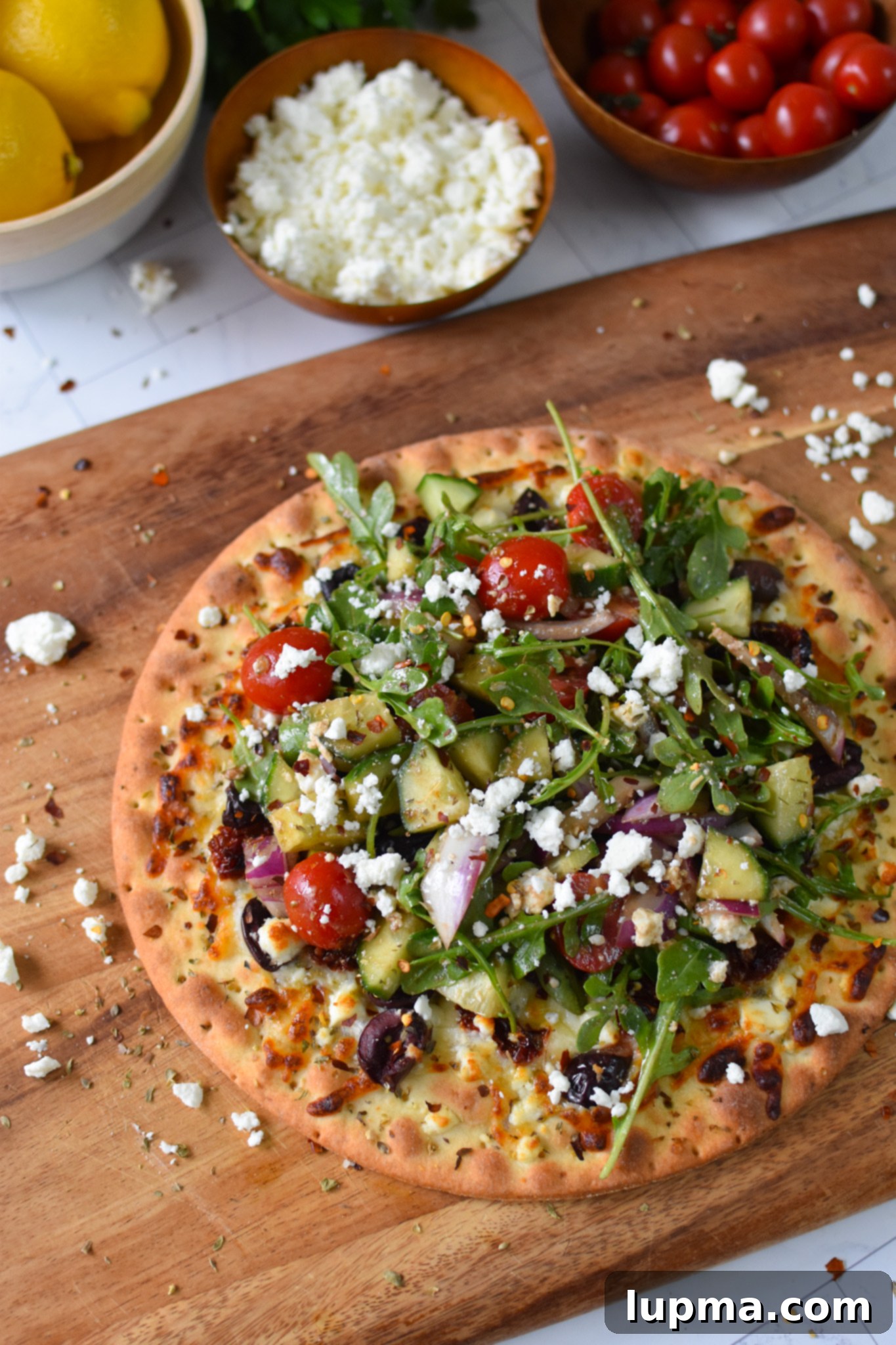
Why You’ll Love This Greek Salad Pizza
As a passionate lover of both pizza and fresh salads, I often find myself serving a crisp green salad alongside my pizzas. This Greek Pizza concept brilliantly merges these two beloved dishes into one harmonious meal. It takes all the vibrant ingredients of a classic Greek salad and artfully arranges them atop a warm, cheesy pizza crust. The result is a meal that feels indulgent yet light, satisfying your pizza cravings while delivering a burst of fresh, wholesome flavors.
The beauty of this recipe lies in its simplicity and the use of accessible ingredients. To make this Mediterranean-inspired pizza incredibly easy to prepare, I highly recommend using a pre-made pizza dough. This significantly cuts down on prep time, allowing you to enjoy a homemade-tasting meal with minimal effort. Simply drizzle your dough with a good quality olive oil and sprinkle with dried oregano to infuse it with an aromatic base that perfectly complements the subsequent toppings.
Once your dough is prepped, the fun begins with layering the foundational flavors. A generous spread of shredded mozzarella cheese creates that essential gooey, bubbly base. This is then adorned with sun-dried tomatoes, briny kalamata olives, and crumbled feta cheese. The pizza is then baked until the crust achieves a beautiful golden hue and the cheeses are melted and bubbling to perfection, hinting at the deliciousness to come.
The true magic happens when the baked pizza emerges from the oven. Just before serving, it’s generously crowned with a freshly tossed Greek salad. This salad features a delightful mix of peppery arugula, crisp cucumbers, sweet cherry tomatoes, more tangy feta cheese, and thinly sliced red onion. Everything is then lightly coated in a zesty balsamic Greek dressing, adding an extra layer of brightness and flavor that elevates the entire dish. This combination creates an irresistible contrast of warm, savory crust and cool, refreshing salad, making every slice an experience.
This Greek Salad Pizza is designed to be a complete meal, bringing together protein, vegetables, and carbohydrates in one flavorful package. However, its versatility allows for endless customization. For an extra layer of gourmet flavor, consider drizzling the finished pizza with a rich balsamic glaze. Fresh herbs like parsley, mint, or dill can add an aromatic freshness, while a sprinkle of crushed red pepper flakes introduces a subtle, warming heat. Don’t hesitate to experiment with other Greek-inspired additions such as marinated artichoke hearts or tangy pepperoncinis to truly make it your own.
If you’re as big a fan of Greek Salad as I am, you’ll definitely want to explore these other fantastic recipes that celebrate those beloved Mediterranean flavors: this hearty Village Greek Salad, the fresh and vibrant Greek Tabbouleh, a protein-packed Grilled Chicken Greek Salad, the satisfying Greek Chickpea Salad, or this uniquely delicious Spiralized Greek Style Salad. They all capture the essence of healthy, flavorful Mediterranean cuisine.
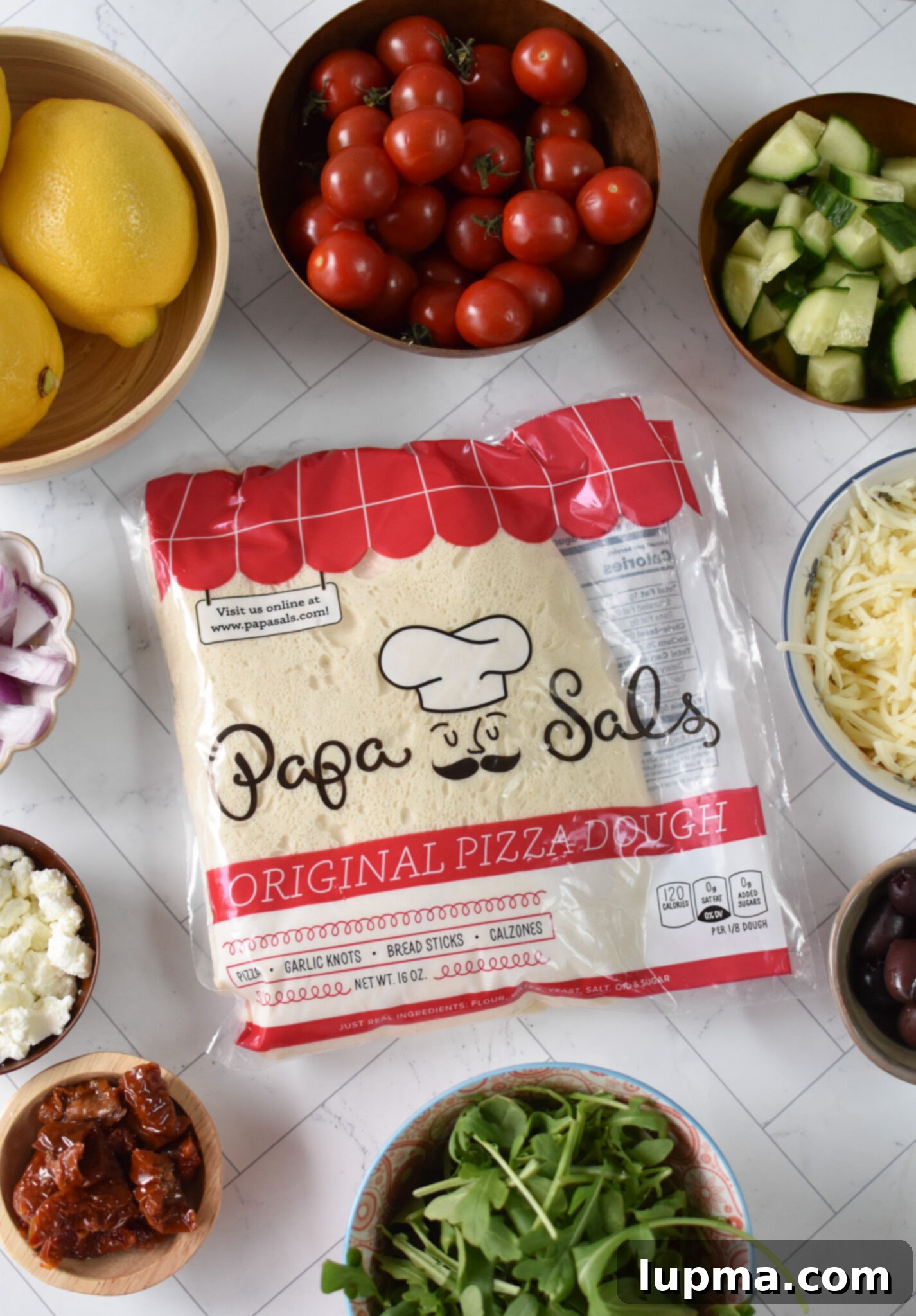
Key Ingredients for Your Delicious Greek Pizza
Crafting this flavorful Greek Pizza begins with selecting fresh, high-quality ingredients that truly bring the Mediterranean essence to life. Here’s a detailed look at what you’ll need to create this culinary masterpiece:
- Pizza Dough: For ultimate convenience and to keep this a quick meal, I highly recommend using 1 pound of pre-made pizza dough. Most grocery stores stock this in their refrigerated section, making it an excellent time-saver. However, if you have a favorite homemade crust recipe or prefer a specific type like whole wheat or sourdough, feel free to use that instead. The key is a good base that can hold up to the delicious toppings.
- Olive Oil: A staple in Mediterranean cooking, good quality olive oil is crucial for both the pizza base and the salad dressing. Its rich, fruity notes add depth of flavor that can’t be replicated. I use a generous drizzle on the dough before baking to create a slightly crispy crust and as the base for the bright Greek dressing.
- Herbs: Dried oregano is a cornerstone herb in Greek cuisine, providing an earthy, aromatic touch to both the pizza and the salad dressing. For an added layer of freshness and visual appeal, fresh parsley makes an excellent garnish for the finished pizza. You can also experiment with fresh mint or dill for different aromatic nuances.
- Cheeses: This recipe calls for a delightful duo of cheeses. Shredded mozzarella creates the classic gooey, stretchy pizza experience, melting beautifully to form a creamy layer. Feta cheese, with its distinct salty and tangy profile, is essential for that authentic Greek flavor. We use it both baked on the pizza and crumbled fresh into the salad topping, ensuring its vibrant taste shines through.
- Pizza Toppings: These are the stars of the baked pizza base. Briny kalamata olives add a wonderful salty depth and a beautiful color contrast. Sun-dried tomatoes, packed with concentrated sweet and savory flavors, offer a chewy texture and a burst of umami. Ensure they are oil-packed for the best flavor and texture.
- Fresh Greek Salad Components: This is where the “salad pizza” truly comes to life.
- Arugula: Its peppery, slightly bitter notes provide a refreshing counterpoint to the rich pizza.
- Cucumber: Diced cucumber adds a cool, crisp texture and refreshing hydration.
- Cherry Tomatoes: Halved cherry tomatoes burst with sweet juiciness, adding a lovely tang and vibrant color.
- Red Onion: Thinly sliced red onion contributes a mild pungency and a satisfying crunch, rounding out the salad’s flavor profile.
- Homemade Greek Dressing: A simple yet powerfully flavorful dressing brings the entire salad together. It combines:
- Olive Oil: The base for richness and a smooth mouthfeel.
- Balsamic Vinegar: Adds a sweet and tangy acidity.
- Fresh Lemon Juice: Brightens all the flavors with a zesty kick.
- Minced Garlic: Provides an aromatic punch.
- Dried Oregano: Reinforces the classic Greek herb profile.
- Salt and Black Pepper: Essential seasonings to balance and enhance all the other flavors.
For exact ingredient amounts and detailed instructions, please refer to the complete recipe card provided below. Mastering these ingredients is the first step to creating a Greek Pizza that will impress everyone at your table!

How to Master Your Greek Salad Pizza: A Step-by-Step Guide
Creating this magnificent Greek Salad Pizza is surprisingly straightforward, especially when you break it down into a few simple steps. Follow this guide to ensure a perfect, flavorful result every time:
Step 1: Prepare Your Pizza Dough and Preheat Oven. Begin by preheating your oven to a robust 400 degrees F (200 degrees C). This ensures the oven is hot enough for a crispy crust. While the oven heats, unroll your pre-made pizza dough onto a lightly floured cutting board or directly onto your baking tray. Gently stretch and shape it into a round pizza, or your desired shape. Transfer the dough to a baking tray, which can be lightly oiled or lined with parchment paper. Brush the entire surface of the pizza dough generously with a tablespoon of olive oil. This not only adds flavor but also helps achieve a golden, crisp crust.
Step 2: Build the Flavorful Base. After brushing with olive oil, sprinkle a teaspoon of dried oregano evenly over the dough. This creates an aromatic foundation. Next, evenly distribute 1 cup of shredded mozzarella cheese over the olive oil and oregano layer. This will form a wonderfully melty base for your Greek toppings.
Step 3: Add the Signature Greek Toppings. Now it’s time to add those unmistakable Greek flavors. Sprinkle the 1/4 cup of kalamata olives and 1/4 cup of sun-dried tomatoes over the mozzarella. Then, evenly scatter half a cup of the crumbled feta cheese (reserve the other half for the fresh salad topping). These ingredients will bake into the pizza, providing rich, savory, and tangy notes.
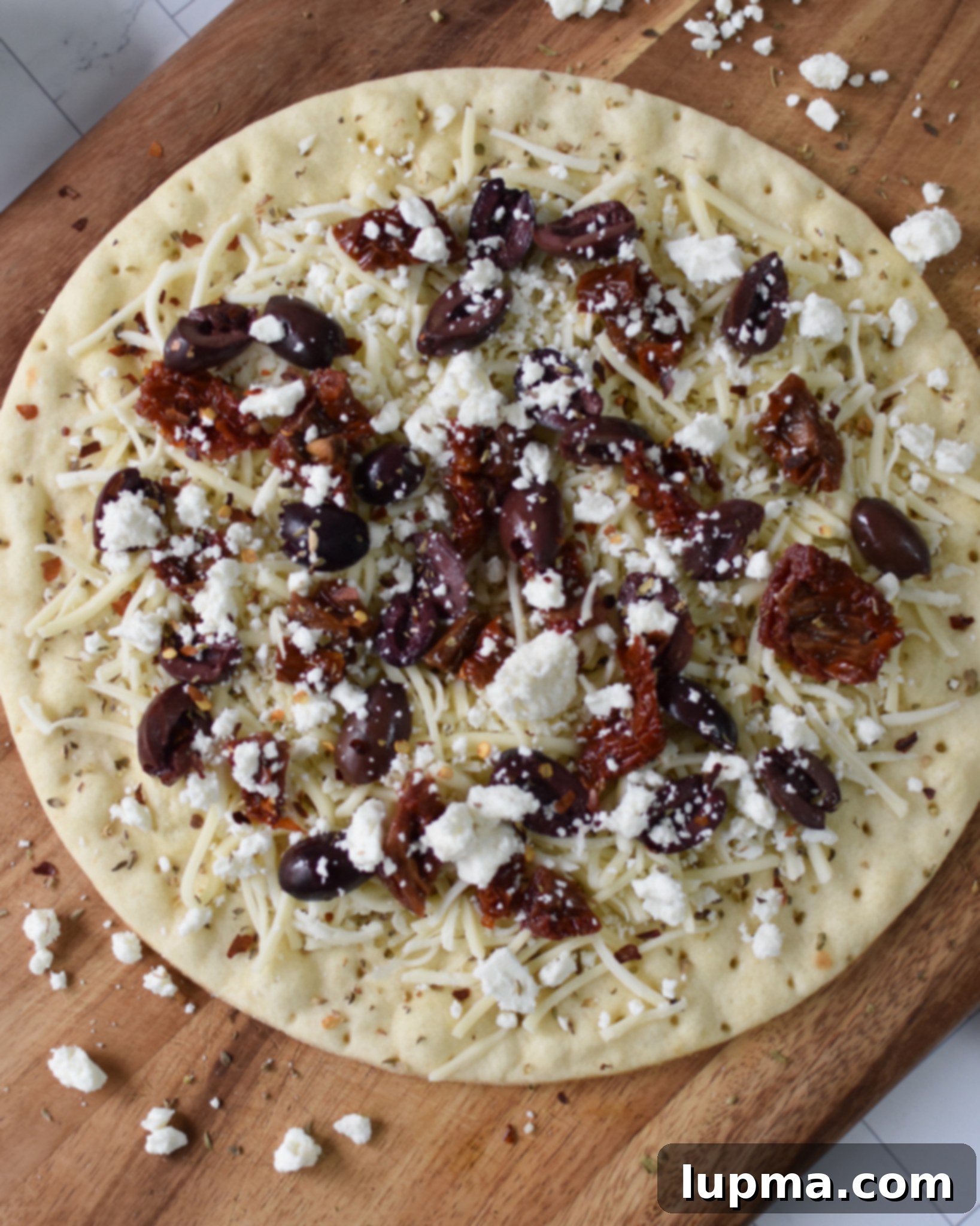
Step 4: Bake to Golden Perfection. Carefully place the baking tray with your prepared pizza into the hot oven. Bake for approximately 10-15 minutes, or until the pizza crust is beautifully golden brown and the cheese is melted, bubbly, and slightly browned in spots. If you’re fortunate enough to own a pizza stone, use it! This will significantly reduce baking time and result in an even crispier crust, possibly cutting the bake time down to 7-8 minutes. Keep a close eye on it to prevent over-browning.
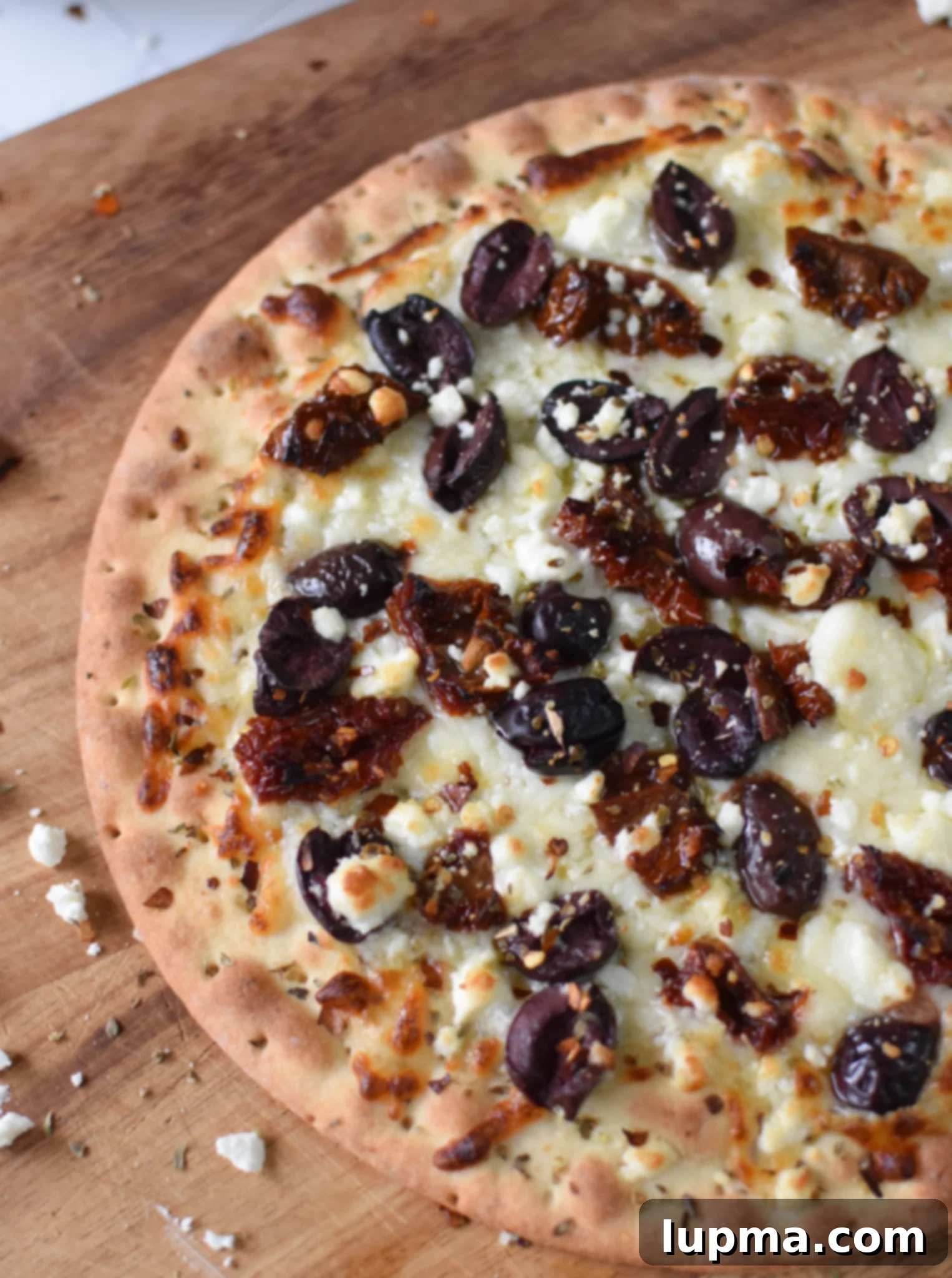
Step 5: Prepare the Fresh Greek Salad Topping. While your pizza is baking, prepare the vibrant salad. In a medium mixing bowl, combine 1 cup of fresh arugula, 1/4 cup of diced cucumber, 1/4 cup of halved cherry tomatoes, the remaining 1/2 cup of crumbled feta cheese, and 1/4 cup of thinly sliced red onion. This fresh mix will add a delightful crunch and coolness to the warm pizza.
Step 6: Whisk Together the Zesty Greek Dressing. In a mason jar or small bowl, combine the ingredients for your Greek dressing: 1/4 cup olive oil, 3 tablespoons balsamic vinegar, 2 tablespoons fresh lemon juice, 1 teaspoon oregano, 1/4 teaspoon salt, and 1/8 teaspoon black pepper. Secure the lid on the mason jar and shake vigorously, or whisk thoroughly until all ingredients are well combined and emulsified. This creates a bright, tangy dressing that perfectly complements the salad. Drizzle 2 tablespoons of this dressing over the arugula salad mixture and gently toss to coat. Add more dressing if desired, ensuring the salad is lightly dressed and not soggy.
Step 7: Finish and Serve Your Masterpiece. Once the pizza is cooked to perfection, carefully transfer it from the baking tray to a cutting board. Immediately top the warm pizza with the freshly dressed Greek salad. The heat from the pizza will slightly wilt the arugula, releasing its peppery aroma. For extra flavor and a beautiful finish, sprinkle a little more dried oregano and a pinch of crushed red pepper flakes over the top. If you like, a final drizzle of balsamic glaze can add a gourmet touch. Slice, serve immediately, and savor every fresh, flavorful bite!
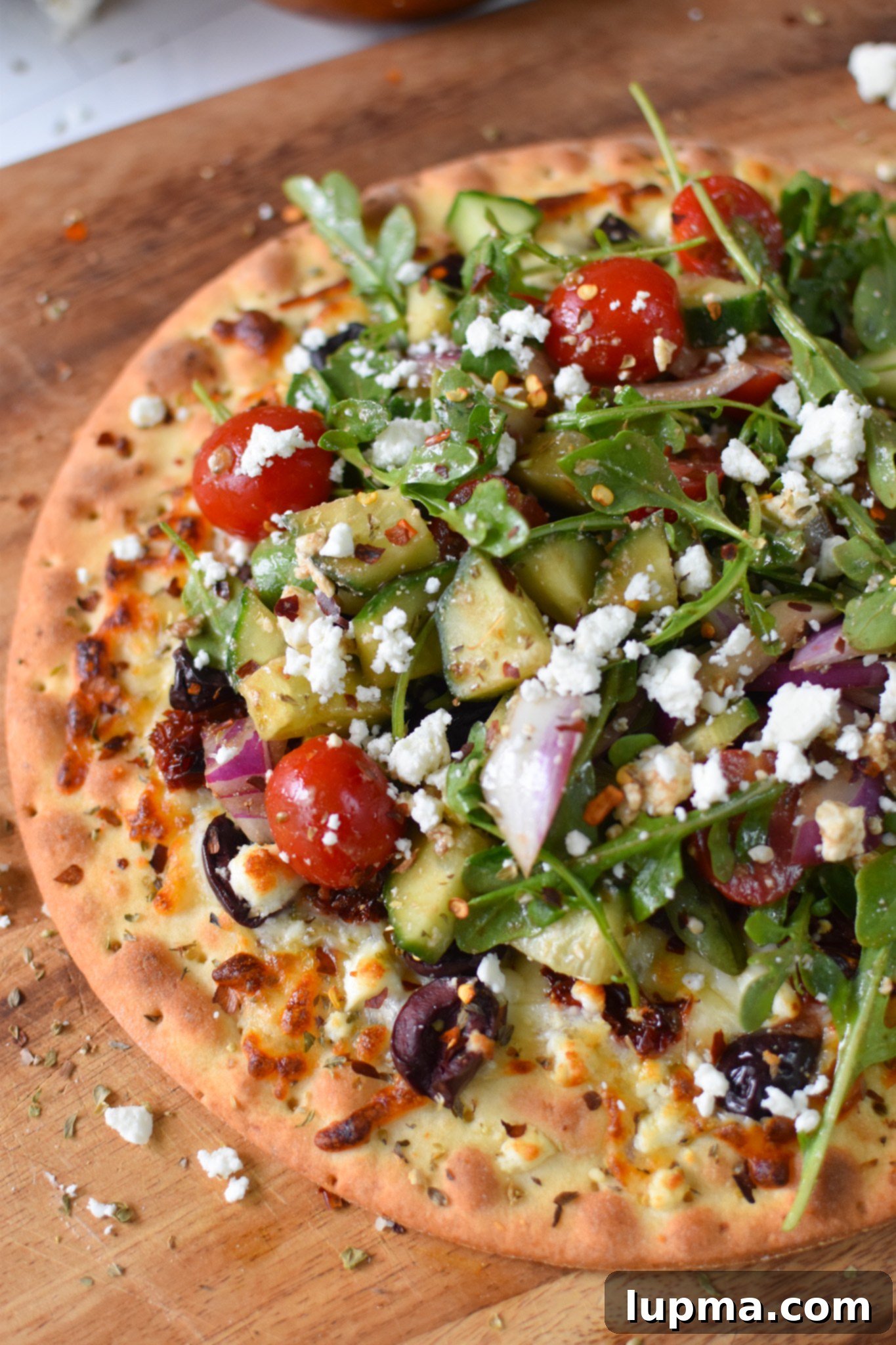
Creative Ways to Modify and Enhance Your Greek Pizza
One of the best aspects of this Greek Pizza recipe is its incredible adaptability. Feel free to unleash your creativity and customize it to suit your personal preferences or what you have on hand. Here are some fantastic ways to modify and elevate your pizza:
- Add More Vegetables: The Mediterranean diet is rich in vegetables, and your pizza can be too! Consider adding a variety of other vegetables to the baked base or the fresh salad topping. Excellent choices include marinated artichoke hearts for a tangy bite, roasted red peppers for sweetness and color, fresh spinach (which will wilt beautifully under the cheese), thinly sliced bell peppers for a fresh crunch, briny capers for a burst of salty flavor, or even some thinly sliced zucchini or eggplant before baking.
- Experiment with the “Sauce”: While this recipe relies on olive oil and the freshness of the salad, you can switch up the base. For a creamy, earthy twist, try using hummus as the “sauce” on the pizza dough before adding the cheese and other toppings. My homemade Lemon Hummus or Lebanese Hummus would be sensational choices, adding a layer of flavor and protein.
- Introduce Proteins: While delicious as a vegetarian option, you can easily add meat for a more substantial meal. A slice or two of savory prosciutto draped over the pizza after baking would be a delightful addition. Cooked, shredded chicken (especially grilled Greek chicken), sliced lamb gyro meat, or even spicy pepperoni can also complement the Greek flavors. Ensure any raw meat is cooked thoroughly before adding to the pizza.
- Alternative Cheeses: If feta isn’t your favorite, or if you’d like to explore other textures and flavors, there are great alternatives. Creamy goat cheese offers a milder tang and a lovely melt. For a salty, umami kick, sprinkle some grated Parmesan cheese. A blend of mozzarella and provolone could also work well for a slightly different texture and sharper taste.
- Spice it Up: For those who love a bit of heat, don’t shy away from adding extra crushed red pepper flakes, either directly to the dough with the oregano, or as a garnish after baking. A pinch of black pepper or a dash of hot sauce in the dressing can also add a delightful kick.
- Add Legumes: Canned chickpeas, rinsed and drained, make a fantastic addition to the salad topping, boosting the protein and fiber content. They add a lovely texture and absorb the dressing beautifully.
These modifications allow you to truly make this Greek Pizza your own signature dish, ensuring it never gets boring and always satisfies your cravings!
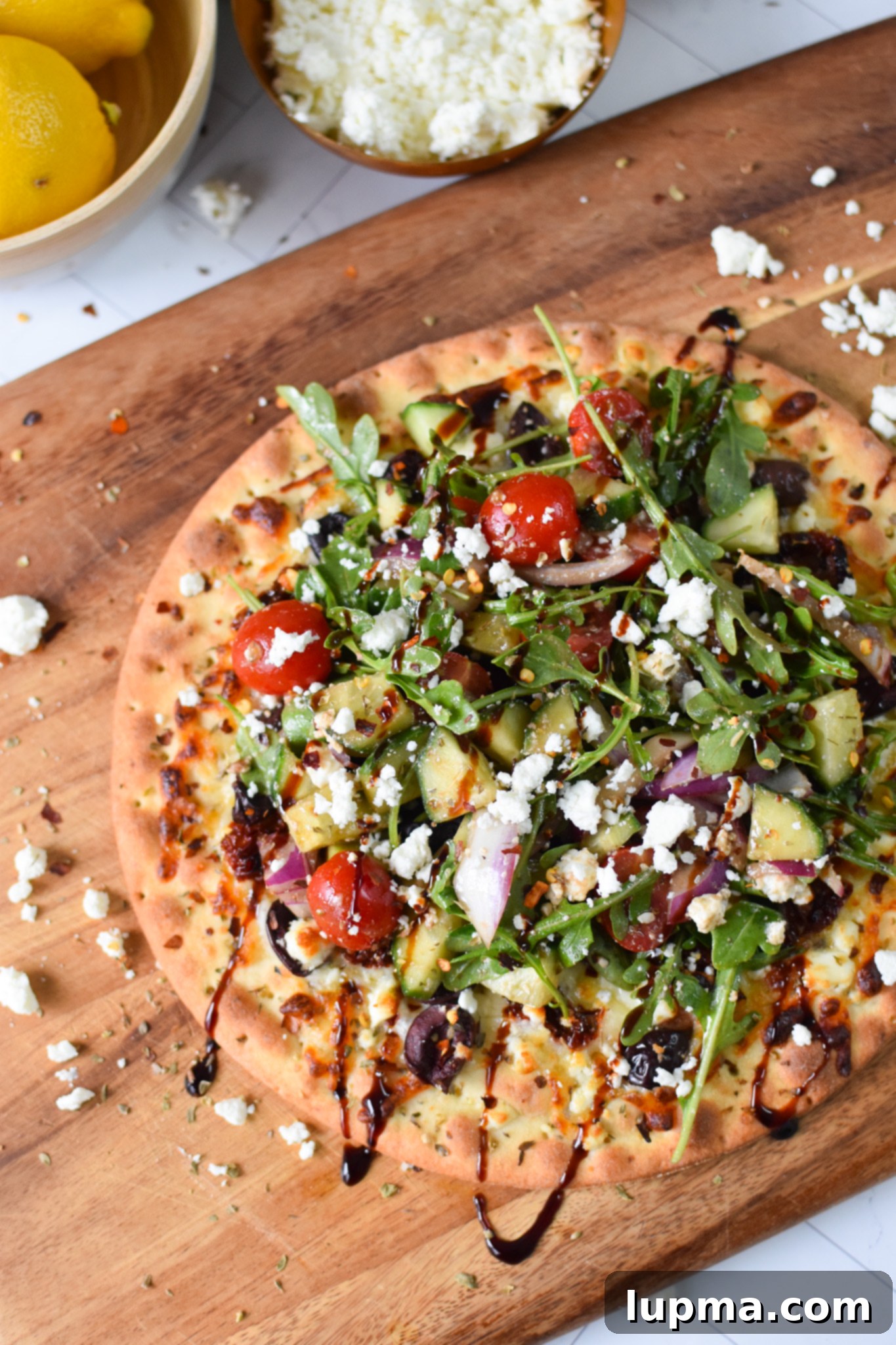
Tips for Storage and Reheating
One of the great things about this Greek Pizza is that it can be enjoyed beyond the initial meal! If you find yourself with leftovers, proper storage and reheating will ensure you can savor its deliciousness for another day:
- Storage: Once the pizza has cooled completely to room temperature, cover it tightly with plastic wrap or aluminum foil, or transfer slices to an airtight container. Store it in the refrigerator for up to 2-3 days. While the salad topping is best when fresh, it will still hold up reasonably well, though the arugula might soften slightly.
- Enjoying Cold: Many people enjoy cold pizza, and this Greek Pizza is no exception! The fresh salad topping makes it particularly delightful straight from the fridge for a quick lunch or snack.
- Reheating: If you prefer your pizza warm, there are a few excellent methods to revive it without making the crust soggy.
- Oven Method: Place individual slices or the entire pizza on a baking sheet. Heat in a preheated oven at 350 degrees F (175 degrees C) for about 8-12 minutes, or until the crust is crispy and the cheese is melted and warm. This is generally the best method for maintaining crust crispness.
- Skillet Method: For a single slice, place it in a non-stick skillet over medium-low heat. Cover the skillet for a few minutes to allow the cheese to melt and the toppings to warm through. Then, uncover and cook for another minute or two until the bottom crust is crispy.
- Air Fryer Method: An air fryer works wonders for reheating pizza, achieving a crisp crust quickly. Place slices in a single layer in your air fryer basket and cook at 350-375 degrees F (175-190 degrees C) for 3-5 minutes, or until heated through and crispy.
Frequently Asked Questions About Greek Pizza
Absolutely, if you have one! Using a preheated pizza stone will significantly improve the crust, making it much crispier and more evenly cooked. It also drastically cuts down on the baking time, often by several minutes. If you don’t have a pizza stone, a heavy baking sheet or a cast-iron pizza pan will also work well, just ensure it’s adequately preheated with the oven.
Yes, there are a couple of ways to prepare this pizza in advance. You can either pre-bake the pizza base with its cheese and non-salad toppings, then let it cool, cover, and refrigerate. When ready to serve, reheat the baked pizza in the oven or air fryer and then add the freshly prepared Greek salad. Alternatively, you can prep all your ingredients (chop vegetables, make the dressing) and store them separately in the refrigerator. Then, simply assemble and cook the pizza when you’re ready to eat, topping it with the fresh salad right before serving.
Yes, this recipe is naturally vegetarian! It relies on fresh vegetables, cheeses, and olives for its robust flavors. It makes an excellent and satisfying meat-free meal. If you want to make it vegan, you would need to use a plant-based pizza dough, substitute the mozzarella and feta with vegan cheese alternatives, and ensure your dressing is entirely plant-based.
While a standard pre-made pizza dough is fantastic for convenience, you can experiment! A thin crust dough will give you a crispier base, closer to a flatbread. A whole wheat dough can add a nutty flavor and more fiber, aligning with a healthier Mediterranean lifestyle. Even a gluten-free crust can be used if you or your guests have dietary restrictions – just ensure it’s cooked according to package instructions.
More Mediterranean Recipes to Explore
Mediterranean
Mediterranean Flatbread
Mediterranean
Mediterranean Naan Bread Pizza
Vegetarian
Mediterranean Hummus Toast with Za’atar
Mediterranean
Mediterranean Roasted Vegetables
Tried this recipe? Leave a star rating and comment below! Subscribe to my newsletter or follow me on
Facebook,
Instagram, or
Pinterest for the latest.
Greek Pizza

Pin
Ingredients
- 1 pound pre-made pizza dough
- 1 tablespoon olive oil
- 1 teaspoon oregano
- 1 cup shredded mozzarella
- 1/4 cup kalamata olives
- 1/4 cup sun-dried tomatoes
- 1 cup feta cheese, divided
- 1 cup arugula
- 1/4 cup cucumber, diced
- 1/4 cup cherry tomatoes, halved
- 1/4 cup red onion, thinly sliced
- Oregano and crushed red pepper flakes for for garnish
- Fresh parsley for garnish
FOR THE GREEK DRESSING
- 1/4 cup olive oil
- 3 tbsps. balsamic vinegar
- 2 tbsps. lemon juice
- 2 garlic cloves, minced
- 1 teaspoon oregano
- 1/4 teaspoon salt
- 1/8 teaspoon black pepper
Instructions
-
Preheat oven to 400 degrees Fahrenheit.
-
Roll the dough on a cutting board and shape into a round pizza.
-
Place the pizza dough on a baking tray and brush with the olive oil.
-
Drizzle the olive oil over the dough then sprinkle the oregano over the olive oil.
-
Sprinkle the mozzarella cheese over the pizza.
-
Top with the olives, sundried tomatoes and 1/2 cup feta cheese.
-
Bake pizzas individually until the crust is golden and the cheese is golden and bubbly, about 10 minutes (the time will be significantly less if you’re using a baking stone).
-
While the pizza cooks combine the arugula, cucumber, tomatoes, 1/2 cup of feta cheese and red onion in a medium mixing bowl.
-
In a mason jar mix together the olive oil, balsamic vinegar, lemon juice, oregano, salt and pepper and whisk until mixed.
-
Toss the arugula salad mixture in 2 tbsps. Greek dressing and toss. Add more dressing as needed.
-
Transfer the pizza to a cutting board and top with the Greek salad.
-
Sprinkle oregano and crushed red pepper on the pizza. You can also drizzle with a balsamic glaze for extra flavor. Serve and enjoy!
Notes
- You can add a variety of other ingredients like artichoke hearts, roasted red peppers, chickpeas, goat cheese, fresh herbs and spinach.
- Try using hummus as the “sauce” on the pizza.
Nutrition
Nutrition information is automatically calculated, so should only be used as an approximation.
